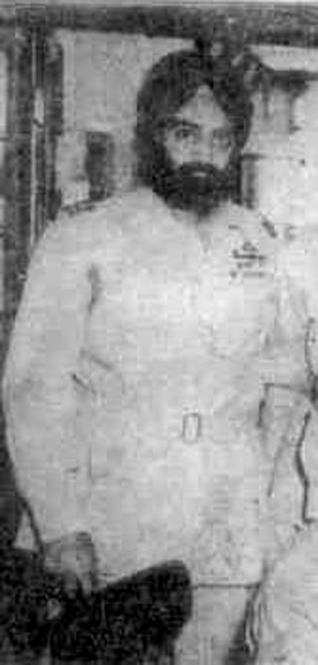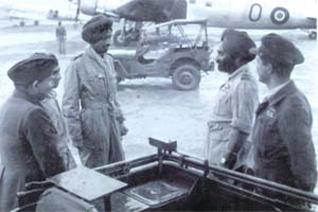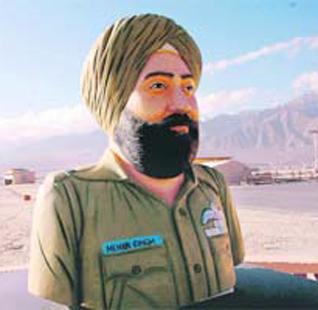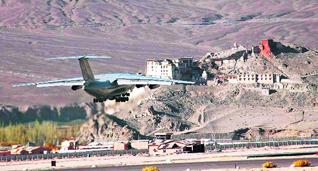
Below, 3rd from bottom: Air Cdre Mehar Singh (2nd from rt) with Flt Lt Lal Singh Grewal at the Leh airfield in May 1948. 2nd from bottom: A Statue of Mehar Singh looks over the Leh airfield today.



Our Heroes
Air Commodore Mehar Singh: Saviour of Ladakh
by Lieut-Gen BALJIT SINGH (retd)
Once the history of any war is diligently imbibed, certain actions and deeds of individuals get imprinted so firmly in memory that they resurface time and again, with the least provocation. So it was that the mere mention of a school child’s last name, a few days ago, brought to mind in a flash her late uncle, the indomitable Air Commodore Mehar Singh, D.S.O., M.V.C.
Now, Squadron Leader Mehar Singh was conferred the first and the only D.S.O. of the Royal Indian Air Force during World War II. Again, within weeks of India’s Independence, Air Cdre Mehar Singh would be marked for the Indian Air Force's first Mahavir Chakra.
On both occasions, recognition came for gallantry and exceptional leadership on the battlefield in two different wars and under gruelling circumstances.
By the time Field Marshal William Slim launched the reinvigorated XIV Army to defeat the Japanese in the India-Burma theatre in 1944, Mehar Singh’s actions and deeds had already placed him in the league of legends. His reputation was aptly and amusingly summed up by the Field Marshal in his memoirs, recounting an impromptu visit to No. 6 Squadron of the RIAF in the Arakans (Burma):
"The last air patrol had run into a bunch of Zeros (Japanese fighter aircraft) and had been shot down. The Sikh Squadron Leader, an old friend of mine, at once took out the next patrol himself and completed the mission. His methods, rumour had it, were a little unorthodox. It was said that if any of his young officers made a bad landing, he would take them behind a basha and beat them. Whatever he did, it was effective; they were a happy, efficient and gallant squadron."
It was not unusual to find entries in Mehar Singh’s log book, flying upward of one hundred hours in a month, time and again. Flt Lieut Asghar Khan, who later became the Chief of Air Staff of Pakistan said: "With the solitary exception of Sqn Ldr Mehar Singh, a pilot of exceptional ability, no one was able to inspire confidence among us."
Mehar Singh was probably in the class of born ace pilots but more than that, he was innovative and daring in his modus operandi. Perhaps his calibre as a flyer and leader was best illustrated when one of his pilots crash-landed but survived and walked back to the base. Within minutes of debriefing the pilot, Mehar Singh had the whole squadron airborne.
It was an unmitigated tragedy when men of this one subcontinent would now be pitched in battles against each other but as citizens of two different nations.
When on January 26, 1950, the Republic of India announced its first gallantry awards, Air Cdre Mehar Singh received the IAF’s first Mahavir Chakra. Unlike the foot soldiers, Mehar Singh in his fighter/ bomber aircraft would be dropping bombs in the Poonch-Rajouri area in the west by night, and at dawn, strafing the enemy bunkers in the north along the Zoji La-Amarnath crest line, hundreds of kilometres apart.
The moment of his ultimate glory came when he created aviation history by landing the first aircraft on the outskirts of Leh, by the banks of the river Indus.
By January 1948, Pakistan’s armed misadventure was fully contained in the Jammu region as also in the Srinagar valley. But for Mehar Singh’s innovative bombing with Dakotas followed by the landing of the first one at a manually-levelled, mere 600-yard strip at Poonch, that tract of India would have been lost to Pakistan. However, it was the lack of road and aerial access to Ladakh year-long which was now a cause of serious concern. It was evident that for the moment airlift of troops and materials to Ladakh was the only course open. It was equally evident that the only man who could pioneer the aerial landing at Leh was Mehar Singh.
In a one-to-one meeting, Major-Gen K S Thimayya emphasised that "the fall of Leh would be a strategic blow to India. It had to be saved at all cost`- that he was prepared to risk his own life with the IAF to save Leh.
Mehar Baba (as the Air Cdre was now affectionately called) explained that "the Dakota was not designed to fly at such high attitude." General Thimayya knew that Mehar Singh never asked his subordinates to undertake a task that he himself had not first carried out, and so he closed the discussion on a positive note : "I will be on that flight in your cockpit. So let's go!"
The stage was thus set for Mehar Baba when, on May 24, 1948, he landed the first Dakota at Leh, on an unprepared surface, 11,540 ft ASL. His passenger was Major-Gen K S Thimayya D.S.O., GOC 19 Div.
To land at Leh, one had to negotiate towering mountains in an ancient Dakota with no heating facilities, no pressurisation and without any surveyed route map. A great pity that no photo-record was made of the first landing, though the next flight of six Dakotas also led personally by Mehar Baba on May 28 was fully covered. The aircraft and crews were literally engulfed this time by the astonished Ladakhis.
Four months after the Leh landing, Mehar Singh resigned his commission. On March 11, 1952, nine days short of his 33rd birthday, he died when the Bonanza aircraft, caught in a freak, sudden storm crashed on the outskirts of Delhi, snuffing out a charmed life.
Death, be not proud;
For, Mehar Baba flies
forever;
In his immortal shroud.
[Courtesy: Tribune]
May 22, 2011
Conversation about this article
1: Ari Singh (Reykjavik, Iceland), May 22, 2011, 5:00 PM.
Dear Baljit Singh ji: Thank you for such an inspiring article! To The Editor, sikhchic.com: There are also Sikhs who were saviours of Kenya (Makhan Singh, Jaswant Singh), of Bangla Desh (General Arora), of Malaysia, etc. More articles of this nature would, indeed, be welcome. Well done.
2: Gur Singh (Chicago, Illinois, U.S.A.), May 22, 2011, 8:21 PM.
I would appreciate an article on what made Major General Shabeg Singh AVSM and PVSM (1925-1984), with a critical analysis of the Indian army's structure.
3: Harinder (Delhi, India), May 22, 2011, 9:26 PM.
We must immortalize our heroes for our coming generations by writing books and making movies about them.
4: Sarvjit (U.S.A.), May 23, 2011, 1:46 PM.
Great article! Mehar Singh, aka Mehar Baba by his colleagues, was the trend setter and pioneer for the Indian Air Force. One elderly Sikh IAF uncle ji told me that Mehar Singh was known for equipping Dakotas with bombs (which was considered an impossible task) and then he used kick the bombs with his shoes to drop them over the enemy through the drop-chutes. I do have one question re the description of the IAF pilot by Gen. Slim, where a Sikh Sqn Ldr used to discipline the pilots behind a basha - it has been referred to elsewhere as pertaining to MIAF Arjan Singh. Was it him or Sqn Ldr Mehar 'Baba' Singh?
5: Aryeh Leib (Israel), May 24, 2011, 4:12 AM.
This is as good a place as any to render heartfelt thanks to the father of Manbir Singh Banwait of Alberta, who flew for the other IAF - the Israel Air Force - in the 1967 Six Day War, and helped turn the tide to accomplish what is generally considered one of the greatest battlefield victories of all time. That a Sikh should have had a hand in it is, to my mind, entirely appropriate. By the way, if you're reading this, Manbir ji, I have yet to find any trace of the Gurdwara in Tel-Aviv; it must be in someone's private home. Whatever it is, they're not advertising their presence. Anyone out there have any more information?
6: Mandeep Singh Jammu (Perth, Australia), May 24, 2011, 6:43 AM.
Originally belonging to Jammu & Kashmir state, I must say that during the 1947 war in Kashmir, most of the Indian Army and Air Force stalwarts were Sikhs. Pritam Singh, Bikram Singh, Mehar Singh were but a few of them. Without these Sikh heroes, Kashmir would have been part of Pakistan today and that's why Sikhs are most respected in Jammu & Kashmir.
7: Sarjit Singh Sandhu (London, England), May 26, 2011, 3:20 PM.
We must work diligently towards getting back control over our destiny. Deg Tegh Fateh!
8: Kanwal Nain Singh (Lindsay, Ontario, Canada), May 26, 2011, 9:39 PM.
I have pleasure in saying that my brother, Group Captain (Retd) G.P.S. Bakhshi who served with the RIAF, later IAF, served in Squadron No.1 in the Burma operation with Baba Mehar Singh. I have heard many stories of Mehar Singh's daredevil sorties in Burma and elsewhere. My brother, GPS, was the first Sikh to be trained in advance gunnery with Lancaster bombers, while in operations against the Japanese. GPS, who is now 90 years old, lives at D411 Defence Colony, New Delhi, India. Any old stalwarts from the First Squadron, or those who may have memories of air warfare in Burma, may like to communicate with him.
9: Mandeep Singh Khurpa (Melbourne, Australia), April 30, 2013, 1:52 PM.
"Baba Mehar Singh" has been listed among the all-time great Punjabi personalities with their detailed achievements by an Australian Punjabi in his informational video ... http://www.youtube.com/watch?v=DNlT1Hqq4Hk&feature=youtu.be
10: Mandeep Singh (India), June 04, 2013, 2:35 PM.
My father Group Capt S.J. Singh had the honour to serve with 'Meher Baba' and L.S. Grewal who is standing next to him in the picture. I remember Dad and Lalu Uncle (L.S. Grewal) telling me that Meher Baba used to have a huge breakfast, sometimes even chicken in the morning, and then work tirelessly throughout the day. He was tough, fair, innovative and inspiring. L.S. Grewal himself was one of the greatest aviators in the world. He was proficient on multiple platforms and in his career he flew 65 kinds of aircraft. He inducted the Fairchild packet into the Indian Air Force (IAF) and when the American test-pilot saw the field he froze and, as Lalu Uncle told me, he couldn't let Lalu Uncle land the aircraft and going back without landing was also not something he wanted to do, so he took instructions from Lalu Uncle and landed the blessed aircraft. Lalu Uncle formed the intel wing of the air force and retired as Vice Chief of the IAF. My dad was on the Dakotas in the 12th squadron when Kashmir was attacked and the first response took off. He was also responsible for saving the life of Defence Minister V. Patel and the Rajasthani royalty. When the aircraft made an emergency landing on a river bed in a desert he navigated the the aircraft. It was an amazing piece of work under duress. I heard great stories about the IAF from both of them. They called it the golden period.


